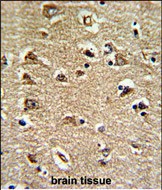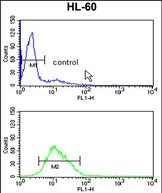RAN Antibody (N-term)
Purified Rabbit Polyclonal Antibody (Pab)
- 产品详情
- 实验流程
- 背景知识
Application
| WB, IHC-P, FC, E |
|---|---|
| Primary Accession | P62826 |
| Other Accession | P52301, P62828, P62827, Q4R4M9, P79735, P42558, O17915, Q3T054, P32836, P32835 |
| Reactivity | Human, Mouse |
| Predicted | Yeast, Bovine, C.Elegans, Chicken, Zebrafish, Monkey, Rat, Xenopus |
| Host | Rabbit |
| Clonality | Polyclonal |
| Isotype | Rabbit IgG |
| Calculated MW | 24423 Da |
| Antigen Region | 12-39 aa |
| Gene ID | 5901 |
|---|---|
| Other Names | GTP-binding nuclear protein Ran, Androgen receptor-associated protein 24, GTPase Ran, Ras-like protein TC4, Ras-related nuclear protein, RAN, ARA24 |
| Target/Specificity | This RAN antibody is generated from rabbits immunized with a KLH conjugated synthetic peptide between 12-39 amino acids from the N-terminal region of human RAN. |
| Dilution | WB~~1:1000 IHC-P~~1:100~500 FC~~1:10~50 E~~Use at an assay dependent concentration. |
| Format | Purified polyclonal antibody supplied in PBS with 0.09% (W/V) sodium azide. This antibody is prepared by Saturated Ammonium Sulfate (SAS) precipitation followed by dialysis against PBS. |
| Storage | Maintain refrigerated at 2-8°C for up to 2 weeks. For long term storage store at -20°C in small aliquots to prevent freeze-thaw cycles. |
| Precautions | RAN Antibody (N-term) is for research use only and not for use in diagnostic or therapeutic procedures. |
| Name | RAN |
|---|---|
| Synonyms | ARA24 {ECO:0000303|PubMed:10400640} |
| Function | GTPase involved in nucleocytoplasmic transport, participating both to the import and the export from the nucleus of proteins and RNAs (PubMed:10400640, PubMed:17209048, PubMed:26272610, PubMed:27306458, PubMed:8276887, PubMed:8636225, PubMed:8692944, PubMed:8896452, PubMed:9351834, PubMed:9428644, PubMed:9822603). Switches between a cytoplasmic GDP- and a nuclear GTP-bound state by nucleotide exchange and GTP hydrolysis (PubMed:11336674, PubMed:26272610, PubMed:29040603, PubMed:7819259, PubMed:8636225, PubMed:8692944, PubMed:8896452, PubMed:9351834, PubMed:9428644, PubMed:9822603). Nuclear import receptors such as importin beta bind their substrates only in the absence of GTP-bound RAN and release them upon direct interaction with GTP-bound RAN, while export receptors behave in the opposite way. Thereby, RAN controls cargo loading and release by transport receptors in the proper compartment and ensures the directionality of the transport (PubMed:8896452, PubMed:9351834, PubMed:9428644). Interaction with RANBP1 induces a conformation change in the complex formed by XPO1 and RAN that triggers the release of the nuclear export signal of cargo proteins (PubMed:20485264). RAN (GTP-bound form) triggers microtubule assembly at mitotic chromosomes and is required for normal mitotic spindle assembly and chromosome segregation (PubMed:10408446, PubMed:29040603). Required for normal progress through mitosis (PubMed:12194828, PubMed:29040603, PubMed:8421051). The complex with BIRC5/survivin plays a role in mitotic spindle formation by serving as a physical scaffold to help deliver the RAN effector molecule TPX2 to microtubules (PubMed:18591255). Acts as a negative regulator of the kinase activity of VRK1 and VRK2 (PubMed:18617507). Enhances AR- mediated transactivation. Transactivation decreases as the poly-Gln length within AR increases (PubMed:10400640). |
| Cellular Location | Nucleus. Nucleus envelope. Cytoplasm, cytosol Cytoplasm. Melanosome Note=Predominantly nuclear during interphase (PubMed:10679025, PubMed:12194828, PubMed:8421051). Becomes dispersed throughout the cytoplasm during mitosis (PubMed:12194828, PubMed:8421051). Identified by mass spectrometry in melanosome fractions from stage I to stage IV (PubMed:17081065). |
| Tissue Location | Expressed in a variety of tissues. |
For Research Use Only. Not For Use In Diagnostic Procedures.
Provided below are standard protocols that you may find useful for product applications.
BACKGROUND
RAN (ras-related nuclear protein) is a small GTP binding protein belonging to the RAS superfamily that is essential for the translocation of RNA and proteins through the nuclear pore complex. The RAN protein is also involved in control of DNA synthesis and cell cycle progression. Nuclear localization of RAN requires the presence of regulator of chromosome condensation 1 (RCC1). Mutations in RAN disrupt DNA synthesis. Because of its many functions, it is likely that RAN interacts with several other proteins. RAN regulates formation and organization of the microtubule network independently of its role in the nucleus-cytosol exchange of macromolecules. RAN could be a key signaling molecule regulating microtubule polymerization during mitosis. RCC1 generates a high local concentration of RAN-GTP around chromatin which, in turn, induces the local nucleation of microtubules. RAN is an androgen receptor (AR) coactivator that binds differentially with different lengths of polyglutamine within the androgen receptor. Polyglutamine repeat expansion in the AR is linked to Kennedy's disease (X-linked spinal and bulbar muscular atrophy). RAN coactivation of the AR diminishes with polyglutamine expansion within the AR, and this weak coactivation may lead to partial androgen insensitivity during the development of Kennedy's disease.
REFERENCES
Monecke,T., Science 324 (5930), 1087-1091 (2009)
Moss,D.K., J. Cell. Sci. 122 (PT 5), 644-655 (2009)
终于等到您。ABCEPTA(百远生物)抗体产品。
点击下方“我要评价 ”按钮提交您的反馈信息,您的反馈和评价是我们最宝贵的财富之一,
我们将在1-3个工作日内处理您的反馈信息。
如有疑问,联系:0512-88856768 tech-china@abcepta.com.























 癌症的基本特征包括细胞增殖、血管生成、迁移、凋亡逃避机制和细胞永生等。找到癌症发生过程中这些通路的关键标记物和对应的抗体用于检测至关重要。
癌症的基本特征包括细胞增殖、血管生成、迁移、凋亡逃避机制和细胞永生等。找到癌症发生过程中这些通路的关键标记物和对应的抗体用于检测至关重要。 为您推荐一个泛素化位点预测神器——泛素化分析工具,可以为您的蛋白的泛素化位点作出预测和评分。
为您推荐一个泛素化位点预测神器——泛素化分析工具,可以为您的蛋白的泛素化位点作出预测和评分。 细胞自噬受体图形绘图工具为你的蛋白的细胞受体结合位点作出预测和评分,识别结合到自噬通路中的蛋白是非常重要的,便于让我们理解自噬在正常生理、病理过程中的作用,如发育、细胞分化、神经退化性疾病、压力条件下、感染和癌症。
细胞自噬受体图形绘图工具为你的蛋白的细胞受体结合位点作出预测和评分,识别结合到自噬通路中的蛋白是非常重要的,便于让我们理解自噬在正常生理、病理过程中的作用,如发育、细胞分化、神经退化性疾病、压力条件下、感染和癌症。










